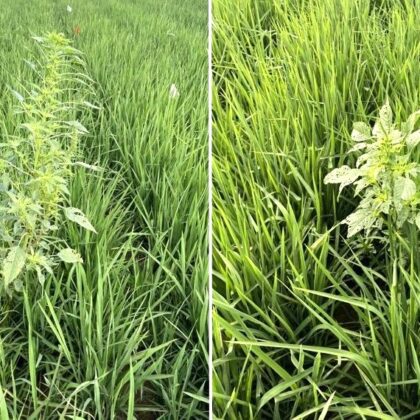Fall-Applied Strategies for Managing Resistant Ryegrass
Fall-applied residual herbicides are among the best available options to use for glyphosate-resistant (GR) Italian ryegrass control, according to a newly published research article in the Weed Science Society of America (WSSA) Weed Technology journal.
“GR Italian ryegrass is one of the most troublesome weeds for rice production in Mississippi,” says Jason A. Bond, Extension/Research Professor, Mississippi State University, Delta Research and Extension Center, and WSSA member-scientist. “This research indicates that fall-applied residual herbicides such as dimethenamid-P (an active ingredient in Outlook®) should be utilized to control GR-resistant Italian ryegrass in Mississippi.”
For their research, Bond and a team at Mississippi State University’s Delta Research and Extension Center conducted two separate field studies during 2021 to 2022 and 2022 to 2023 in Stoneville, Mississippi. They evaluated GR Italian ryegrass control with fall-applied residual herbicide mixtures (Herbicide Mixture Study) and sequential PRE followed by POST herbicide programs with multiple applications of residual herbicides (Sequential Herbicide Application Study).
In Mississippi, rice production typically requires a fall- or early-spring herbicide application because reducing undesirable vegetation at the time of seeding is key for establishing an adequate rice stand, explains Bond. To accomplish this, preplant herbicide applications (burndown) must be timely and are most often applied during February or March in Mississippi, he adds.
“In the Herbicide Mixture Study, dimethenamid-P (Outlook®), pyroxasulfone (Zidua®), and S-metolachlor (Dual Magnum®) alone provided greater than 94% control of GR Italian ryegrass 21 days after treatment (DAT),” reports Bond. He adds that the study confirms fall-applied residual herbicides are a necessary component for GR Italian ryegrass control programs in Mississippi.

More information about glyphosate-resistant Italian ryegrass weed control in rice production can be found in the Weed Technology article, “Glyphosate-resistant Italian ryegrass (Lolium perenne ssp. multiflorum) control in preemergence and postemergence programs containing mixtures of residual herbicides.” Weed Technology is a WSSA journal, published online by Cambridge University Press.
About Weed Technology
Weed Technology is a journal of the Weed Science Society of America, a nonprofit scientific society focused on weeds and their environmental impact. Weed Technology publishes original research and scholarship in the form of peer-reviewed articles focused on understanding how weeds are managed. The journal focuses on applied aspects concerning weed management in agricultural systems, weed/crop management systems, new weed problems, new technologies for weed management, herbicides used to manage undesired vegetation, and special articles emphasizing technology transfer to improve weed control. To learn more, visit www.wssa.net.
Media Contact:
Jason K. Norsworthy, Ph.D.
Editor – Weed Technology
479-313-1265






